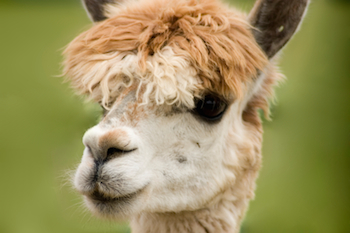Llamas make especially tiny antibodies that can neutralize 60 strains of HIV.
Known for being sturdy and dependable animals, leave it to llamas to deliver some good news in the slow-going quest for an HIV vaccine.
(learn more about ProSci’s custom llama antibodies here)
Research published today in the journal PLOS Pathogens shows that scientists at University College London have pinpointed five HIV-neutralizing antibodies in llama blood.
Previous research suggested that llamas given an experimental HIV vaccine produce virus-fighting antibodies that are smaller than those produced by humans. As a result, these smaller antibodies do a better job of latching onto the receptors in human cells where part of the virus lives. An HIV vaccine should target these receptors.
In the latest experiment, researchers wanted to see if these llama antibodies could block HIV from infecting human cells. Even though all of the llama antibodies targeted the same site in the cells, they didn’t compete with one another and cancel out their positive effects. This is a common problem for HIV researchers.
“The strongest neutralizing antibody always won,” lead author Laura McCoy explained to Healthline.
In fact, some of the antibodies worked better than others against different strains of HIV. McCoy’s research showed that the llama antibodies could neutralize 60 different strains of HIV when used together.
Can Llama Antibodies Really Help Humans?
McCoy, who has since moved to the Scripps Research Institute in San Diego, explained how these findings could be applied to the development of a human HIV vaccine.
 We can’t get human bodies to produce these smaller antibodies to fight HIV. But McCoy said that another option would be to inject the llama antibodies into humans.
We can’t get human bodies to produce these smaller antibodies to fight HIV. But McCoy said that another option would be to inject the llama antibodies into humans.
“A caveat is that [humans] might have a reaction against antibodies from a llama, so it would need to be carefully evaluated for safety and efficacy,” she said.
One possible way to get the llama antibodies safely into human patients is to genetically edit them. Editing and modifying genes is known as gene therapy. Scientists are able to modify or disable parts of genes using gene editing in order to influence how a cell works.
It wouldn’t be the first time animal antibodies were genetically edited to be more human-friendly. McCoy said that a therapy recently given to two American Ebola patients contained humanized mouse antibodies. “The humanization process reduces the risk of a cross-species reaction, so it could potentially work,” she said.
Becoming More Powerful with Practice
McCoy’s work also showed that the llama antibodies evolved after repeated exposure to vaccine candidates. The llamas received eight injections in total. The antibodies became more powerful as they evolved.
Alejandro Balazs of the Ragon Institute made similar advances when he developed an approach known as vectored immunoprophylaxis, or VIP. Balazs worked with antibodies that rapidly mutate with repeated exposure to the virus and are able to conquer it. He showed that they could be injected into humanized mice to work as a barrier to HIV infection.
“It could be that we need repeated rounds of vaccination to teach the immune system,” McCoy said.
For her part, she is focused on studying individual antibodies to find those with the most powerful properties. “There is a need now to evaluate other HIV vaccine studies in this way and see if such highly functioning antibodies can be produced in the normal format,” McCoy said.
Find out how ProSci can help your Antibody needs today!
